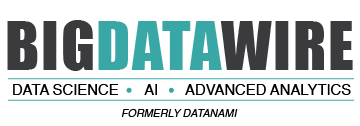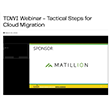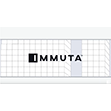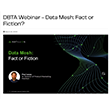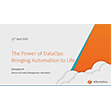

(DmitriyRazinkov/Shutterstock)
Before you can turn your big data set into something of tangible value through SQL analytics or machine learning, you need to get a firm handle on it. That is not always easy, and is often the crux of the big data problem itself. In its latest report on metadata management, Gartner delves into the issue at play and the 14 vendors setting the pace in this increasingly important field.
Practitioners of big data analytics would do well to check out Gartner‘s latest Magic Quadrant of Metadata Management. While the term “metadata management” may carry echoes of old-school business intelligence initiatives, Gartner uses the category a catch-all for many of the individual tool categories – including data governance and cataloging, which we’ve added to our 2017 Datanami Reader’s Choice Awards — that are emerging as critical to big data analytic initiatives.
As Gartner analysts Guido De Simoni and Roxane Edjlali state in their August 10 report, metadata management “builds the foundations for describing, inventorying, and understanding data for multiple use cases such as information governance or analytics.”
Basically, if you don’t know what data you have, where it’s stored, how you got it, who has access to it, how you’re using it, and how it’s changing, then the odds of successfully leveraging that data for some useful end – be it improving sales margins, optimizing product recommendations, or detecting financial fraud – are not good. When you factor in the looming GDPR deadline driving compliance initiatives and the ongoing crises around data breaches, it’s clear that that metadata is (or should be) playing an increasingly large role in organization’s data initiatives.
Metadata is key because it gives organizations a lever to manage the terabytes or petabytes of actual data that they want to analyze. That’s why Gartner is now devoting resources to tracking the vendors and tools that make up the market.
Gartner published its first Magic Quadrant for Metadata Management Solutions in 2016 with nine vendors. In looking at the 2017 report, it’s interesting to note how things have changed. For starters, there are five additional vendors, bringing the total to 14.
But one thing that hasn’t changed is Informatica‘s dominance of the market. The company owns, far and away, the best piece of real-estate in the quadrant itself – farther up and farther to the right than any other vendor, indicating its superior vision and ability to execute, at least in Gartner’s eyes.
In 2016, Informatica was joined by IBM, Collibra, and Adaptive in the Leader’s quadrant. This year, the Leader’s quadrant gets a bit busier, with Alation, Oracle, Smartlogic, and Datum joining the ranks, while Adaptive fell to the Visionaries quadrant. A total of 14 vendors made the cut for this year’s quadrant.
Joining Adaptive in the Visionaries quadrant is Global IDs (which occupied the same spot in 2016); SAP, which moved from the Challengers quadrant in 2016; and Australian firm Alex Solutions, which debuts here. Data Advantage Group reprises its 2016 role as a Challenger, while Cambridge Semantics and Infogix are listed as Niche Players.
The metadata management market is growing quickly, and is expected to continue growing in the near future. In its 2016 report, Gartner predicted that the field would double in size in 2017, from about $170 million to about $340 million this year. The analyst group didn’t tell us how it fared with that prediction, except to say that the market “has shown significant growth during 2017 and the growth will continue with pace in 2018.”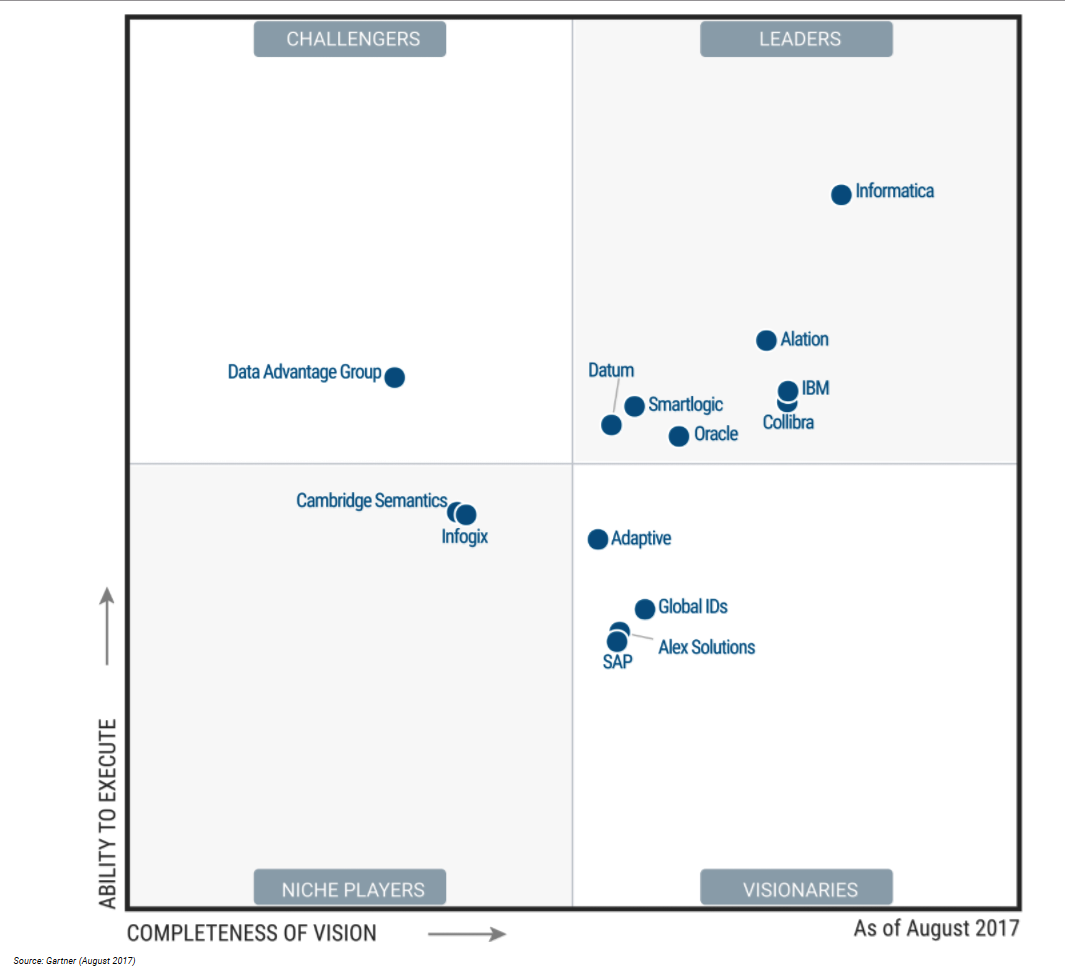
Just as data itself continues to change and evolve, so too is the metadata market. Some product trends noted by Gartner include an expansion of the types of metadata supported, as well as automated enrichment of metadata through machine learning, crowdsourcing, search capabilities, and other processes.
Semantic data tools, such as entity relationship (ER) models and modeling languages like Resource Description Framework (RDF) also play heavily in the metadata management field, and Gartner sees “formal ontologies” improving interoperability. Garter also highlighted cross-domain sharing of metadata as a trend, as well as the rise of self-service data preparation (which Datanami considers a separate category) as impacting the overall metadata management tool market.
There are clearly benefits from using metadata management tools. If you need to get a handle on your data, then a good place to start is finding ways to wrangle the metadata that describes it. In fact, Gartner estimates that, by 2020, 50% of information governance initiatives will be enacted with policies based on metadata alone. That’s something worth considering as you map out your big data analytics and AI initiatives.
Related Items:
GDPR: Say Goodbye to Big Data’s Wild West
Avoid These Five Big Data Governance Mistakes
A Semantic Approach to Big Data Governance
February 19, 2025
- AtScale and Snowflake Announce Integration with Cortex Analyst to Deliver Trustworthy Natural Language Queries
- Sawmills Exits Stealth with $10M to Tackle Skyrocketing Observability Costs Using AI
- Prophecy Finds GenAI Boosting Data Team Productivity by Up to 50%
- CTERA Enhances Cybersecurity and AI Capabilities in Record-Setting Year
- VAST Data Introduces Event Broker for AI-Driven Real-Time Streaming
- DiffusionData Announces Free Trial of Diffusion Cloud
- Cube Launches Cube Cloud for the Microsoft Enterprise
- VAST Data Adds Block Storage to Unify Enterprise AI and Hybrid Workloads
February 18, 2025
- Boomi Unveils Comprehensive API Management to Combat Sprawl and Power Agentic AI
- Grid Status Launches Power Market Datasets on Snowflake Marketplace
- Gartner Predicts 40% of AI Data Breaches Will Arise from Cross-Border GenAI Misuse by 2027
- Fortanix Releases 2025 State of Data Security in GenAI Report
- Vultr Announces Availability of AMD Instinct MI325X GPUs to Power Enterprise AI
- SiMa.ai Advances Edge AI with Efficient Implementation of DeepSeek R1 Model
February 14, 2025
- Clarifai Unveils Control Center for Enhanced AI Visibility and Decision-Making
- EDB Strengthens Partner Program to Accelerate Postgres and AI Adoption Worldwide
- Workday Introduces Agent System of Record for AI Workforce Management
- Fujitsu Unveils Generative AI Cloud Platform with Data Security Focus
- NTT DATA Highlights AI Responsibility Gap as Leadership Fails to Keep Pace
- Gurobi AI Modeling Empowers Users with Accessible Optimization Resources
- OpenTelemetry Is Too Complicated, VictoriaMetrics Says
- What Are Reasoning Models and Why You Should Care
- Three Ways Data Products Empower Internal Users
- Keeping Data Private and Secure with Agentic AI
- Memgraph Bolsters AI Development with GraphRAG Support
- Three Data Challenges Leaders Need To Overcome to Successfully Implement AI
- Top-Down or Bottom-Up Data Model Design: Which is Best?
- PayPal Feeds the DL Beast with Huge Vault of Fraud Data
- What Leonardo DaVinci Teaches Us About Data Management
- Inside Nvidia’s New Desktop AI Box, ‘Project DIGITS’
- More Features…
- Meet MATA, an AI Research Assistant for Scientific Data
- AI Agent Claims 80% Reduction in Time to Complete Data Tasks
- DataRobot Expands AI Capabilities with Agnostiq Acquisition
- Snowflake Unleashes AI Agents to Unlock Enterprise Data
- Collibra Bolsters Position in Fast-Moving AI Governance Field
- Microsoft Open Sources Code Behind PostgreSQL-Based MongoDB Clone
- AI Making Data Analyst Job More Strategic, Alteryx Says
- Observo AI Raises $15M for Agentic AI-Powered Data Pipelines
- Anaconda’s Commercial Fee Is Paying Off, CEO Says
- Confluent and Databricks Join Forces to Bridge AI’s Data Gap
- More News In Brief…
- Informatica Reveals Surge in GenAI Investments as Nearly All Data Leaders Race Ahead
- Gartner Predicts 40% of Generative AI Solutions Will Be Multimodal By 2027
- PEAK:AIO Powers AI Data for University of Strathclyde’s MediForge Hub
- DataRobot Acquires Agnostiq to Accelerate Agentic AI Application Development
- Cloudera Welcomes Tom Brady as Keynote Speaker at ELEVATE26
- TigerGraph Launches Savanna Cloud Platform to Scale Graph Analytics for AI
- EY and Microsoft Unveil AI Skills Passport to Bridge Workforce AI Training Gap
- Alluxio Enhances Enterprise AI with Version 3.5 for Faster Model Training
- DeepSeek-R1 models now available on AWS
- Lightning AI Brings DeepSeek to Private Enterprise Clouds with AI Hub
- More This Just In…
